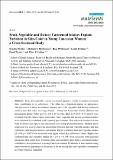Files in this item
Fruit, vegetable and dietary carotenoid intakes explain variation in skin-color in young caucasian women : a cross-sectional study
Item metadata
| dc.contributor.author | Pezdirc, Kristine | |
| dc.contributor.author | Hutchesson, Melinda J. | |
| dc.contributor.author | Whitehead, Ross | |
| dc.contributor.author | Ozakinci, Gozde | |
| dc.contributor.author | Perrett, David | |
| dc.contributor.author | Collins, Clare E. | |
| dc.date.accessioned | 2015-07-15T12:10:04Z | |
| dc.date.available | 2015-07-15T12:10:04Z | |
| dc.date.issued | 2015-07-15 | |
| dc.identifier | 202705201 | |
| dc.identifier | 5f6e1c36-48cf-47b5-b967-26192a866a62 | |
| dc.identifier | 84937459088 | |
| dc.identifier | 000359349800043 | |
| dc.identifier.citation | Pezdirc , K , Hutchesson , M J , Whitehead , R , Ozakinci , G , Perrett , D & Collins , C E 2015 , ' Fruit, vegetable and dietary carotenoid intakes explain variation in skin-color in young caucasian women : a cross-sectional study ' , Nutrients , vol. 7 , no. 7 , pp. 5800-5815 . https://doi.org/10.3390/nu7075251 | en |
| dc.identifier.issn | 2072-6643 | |
| dc.identifier.other | Bibtex: urn:cb818942dbd1bf5ffdf0231ff83aa822 | |
| dc.identifier.other | ORCID: /0000-0001-5869-3274/work/27163471 | |
| dc.identifier.other | ORCID: /0000-0002-6025-0939/work/64360972 | |
| dc.identifier.uri | https://hdl.handle.net/10023/6991 | |
| dc.description | This work was supported by a scholarship top-up grant from HMRI. Kristine Pezdirc is supported by an Australian Postgraduate Awards scholarship. Melinda Hutchesson is supported by a Postdoctoral Fellowship (100177) from the National Heart Foundation of Australia. | en |
| dc.description.abstract | Fruit and vegetables contain carotenoid pigments, which accumulate in human skin, contributing to its yellowness. This effect has a beneficial impact on appearance. The aim was to evaluate associations between diet (fruit, vegetable and dietary carotenoid intakes) and skin color in young women. Ninety-one Caucasian women (Median and Interquartile Range (IQR) age 22.1 (18.1–29.1) years, BMI 22.9 (18.5–31.9) kg/m2) were recruited from the Hunter region (Australia). Fruit, vegetable and dietary carotenoid intakes were estimated by a validated food frequency questionnaire. Skin color was measured at nine body locations (sun exposed and unexposed sites) using spectrophotometry. Multiple linear regression was used to assess the relationship between fruit and vegetable intakes and skin yellowness adjusting for known confounders. Higher combined fruit and vegetable intakes (β = 0.8, p = 0.017) were associated with higher overall skin yellowness values. Higher fruit combined fruit and vegetable intakes (β = 1.0, p = 0.004) were associated with increased unexposed skin yellowness. Combined fruit and vegetables plus dietary carotenoid intakes contribute to skin yellowness in young Caucasian women. Evaluation of interventions using improvements in appearance as an incentive for increasing fruit and vegetable consumption in young women is warranted. | |
| dc.format.extent | 16 | |
| dc.format.extent | 380722 | |
| dc.language.iso | eng | |
| dc.relation.ispartof | Nutrients | en |
| dc.subject | Fruit | en |
| dc.subject | Vegetables | en |
| dc.subject | Skin color | en |
| dc.subject | Skin reflectance | en |
| dc.subject | Dietary carotenoids | en |
| dc.subject | R Medicine | en |
| dc.subject | NDAS | en |
| dc.subject.lcc | R | en |
| dc.title | Fruit, vegetable and dietary carotenoid intakes explain variation in skin-color in young caucasian women : a cross-sectional study | en |
| dc.type | Journal article | en |
| dc.contributor.institution | University of St Andrews. Child and Adolescent Health Research Unit | en |
| dc.contributor.institution | University of St Andrews. School of Medicine | en |
| dc.contributor.institution | University of St Andrews. St Andrews Sustainability Institute | en |
| dc.contributor.institution | University of St Andrews. Health Psychology | en |
| dc.contributor.institution | University of St Andrews. School of Psychology and Neuroscience | en |
| dc.contributor.institution | University of St Andrews. Institute of Behavioural and Neural Sciences | en |
| dc.contributor.institution | University of St Andrews. Centre for Social Learning & Cognitive Evolution | en |
| dc.identifier.doi | 10.3390/nu7075251 | |
| dc.description.status | Peer reviewed | en |
| dc.identifier.url | http://www.mdpi.com/2072-6643/7/7/5251 | en |
This item appears in the following Collection(s)
Items in the St Andrews Research Repository are protected by copyright, with all rights reserved, unless otherwise indicated.

